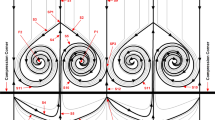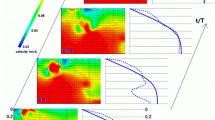Abstract
An experimental study was conducted in a transonic channel to control by mechanical vortex generator devices the strong interaction between a shock wave and a separated turbulent boundary layer. Control devices—co-rotating and counter-rotating vane-type vortex generators—were implemented upstream of the shock foot region and tested both on a steady shock wave and on a forced shock oscillation configurations. The spanwise spacing of vortex generator devices along the channel appeared to be an important parameter to control the flow separation region. When the distance between each device is decreased, the vortices merging is more efficient to reduce the separation. Their placement upstream of the shock wave is determinant to ensure that vortices have mixed momentum all spanwise long before they reach the separation line, so as to avoid separation cells. Then, vortex generators slightly reduced the amplitude of the forced shock wave oscillation by delaying the upstream displacement of the leading shock.
Similar content being viewed by others
References
Pearcey H.H.: Shock induced separation and its prevention by design and boundary layer control. In: Lachmann, G.V.(eds) Boundary Layer and Flow Control, vol. 2, pp. 1312–1314. Pergamon, Oxford (1961)
Stanewsky E.: Adaptive wing and flow control technology. Prog. Aero. Sci. 37, 583–667 (2001)
Ashill P.R., Fulker J.L., Hackett K.C.: A review of recent developments in flow control. Aeronaut. J. 109, 205–232 (2005)
Lin J.C.: Review of research on low-profile vortex generators to control boundary layer separation. Prog. Aero. Sci. 38, 389–420 (2002)
McCormick, D.C.: Shock-boundary layer interaction control with low-profile vortex generators and passive cavity. AIAA Paper 92-0064, 30th AIAA Aerospace Sciences Meeting and Exhibit, Reno, NV (1992)
Ashill, P.R., Fulker, J.L., Hackett, K.C.: Research at DERA on sub boundary layer vortex generators (SBVGs). AIAA Paper 2001-0887, 39th AIAA Aerospace Sciences Meeting and Exhibit, Reno, NV (2001)
Babinsky, H., Makinson, N.J., Morgan, C.E.: Micro-vortex generator flow control for supersonic engine inlets. AIAA Paper 2007-0521, 45th AIAA Aerospace Sciences Meeting and Exhibit, Reno, NV (2007)
Galli, A.: Contrôle de l’oscillation d’une onde de choc en écoulement transsonique de canal. Ph. D. thesis, University of Provence Aix-Marseille I (2005)
Délery J.: Analysis of the separation due to shock wave - turbulent boundary layer interaction in transonic flow. Aero. Res. 6, 305–320 (1978)
Galli A., Corbel B., Bur R.: Control of forced shock-wave oscillations and separated boundary layer interaction. Aero. Sci. Tech. 9, 653–660 (2005)
Sajben M., Bogar T.J., Kroutil J.: Forced oscillation experiments in supercritical diffuser flows. AIAA J. 22, 465–474 (1984)
Salmon J.T., Bogar T.J., Sajben M.: Laser Doppler velocimeter measurements in unsteady, separated, transonic diffuser flows. AIAA J. 21, 1690–1697 (1983)
Ott P., Bölcs A., Fransson T.: Experimental and numerical study of the time-dependent pressure response of a shock-wave oscillating in a nozzle. ASME J. Turbo. 117, 106–114 (1995)
Pauley W.R., Eaton J.K.: Experimental study of the development of longitudinal vortex pairs embedded in a turbulent boundary layer. AIAA J. 26, 816–823 (1988)
Godard G., Stanislas M.: Control of a decelerating boundary layer. Part 1: Optimization of passive vortex generators. Aero. Sci. Tech. 10, 181–191 (2006)
Coudert, L.: Contrôle par générateurs de tourbillons d’une interaction onde de choc / couche limite avec décollement en écoulement transsonique. Master 2 report of University of Poitiers (2007)
Dandois, J., Brunet, V., Molton, P., Abart, J-C., Lepage, A.: Buffet Control by Means of Mechanical and Fluidic Vortex Generators. CEAS/KATnet II Conference, Bremen, Germany (2009)
Author information
Authors and Affiliations
Corresponding author
Additional information
Communicated by J.-P. Dussauge.
Rights and permissions
About this article
Cite this article
Bur, R., Coponet, D. & Carpels, Y. Separation control by vortex generator devices in a transonic channel flow. Shock Waves 19, 521–530 (2009). https://doi.org/10.1007/s00193-009-0234-6
Received:
Revised:
Accepted:
Published:
Issue Date:
DOI: https://doi.org/10.1007/s00193-009-0234-6




